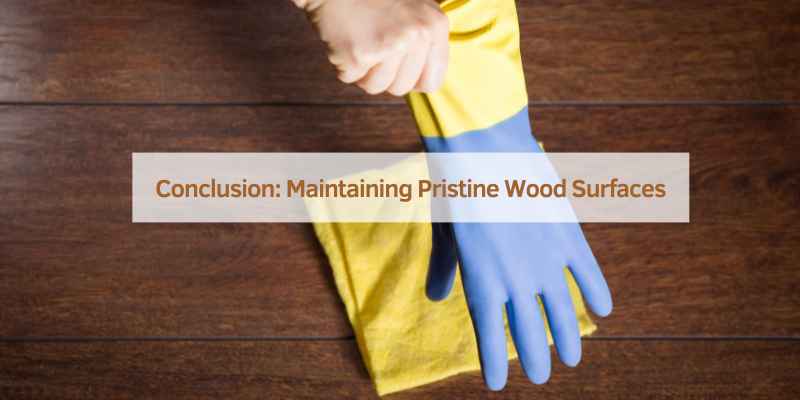To remove fingerprints from wood, gently wipe the surface with a soft, microfiber cloth dampened with a mixture of warm water and mild dish soap.
Introduction To Fingerprint Marks On Wood
Remove fingerprints from wood by gently wiping the surface with a soft, damp cloth. For stubborn marks, apply a mixture of vinegar and water, or use a commercial wood cleaner. Avoid abrasive materials that may damage the wood, and always test any cleaning solution on a small, inconspicuous area first.
The Challenge Of Keeping Wood Clean
Cleaning wood is a task that requires a delicate touch. Dust, dirt, and fingerprints can easily accumulate on wooden surfaces, making them look dull and unattractive. While it’s relatively easy to remove dust and dirt, removing fingerprints can be quite challenging. Fingerprints can leave behind oils and acids that can damage the wood over time. Therefore, it’s essential to learn how to remove fingerprints from wood without causing any harm.
Why Fingerprints Appear On Wooden Surfaces
Wooden surfaces are prone to fingerprints because they are often touched. Oils and sweat from our hands can easily transfer onto the wood, leaving behind unsightly marks. Additionally, wood is a porous material that can absorb oils and acids, making the fingerprints harder to remove. Over time, these oils and acids can also cause discoloration and damage to the wood.
Removing Fingerprints From Wood
To remove fingerprints from wood, you’ll need to use a gentle cleaning solution and a soft cloth. Here are the steps to follow:
- Mix a small amount of dish soap and warm water in a bowl.
- Dip a soft cloth into the solution and wring out any excess water.
- Gently rub the cloth over the fingerprint mark, being careful not to scrub too hard.
- Rinse the cloth with clean water and wring out any excess water.
- Gently rub the cloth over the area again to remove any soap residue.
- Dry the area with a clean, dry cloth.
If the fingerprint mark is particularly stubborn, you can also try using a mixture of baking soda and water. Mix equal parts baking soda and water to form a paste. Gently rub the paste over the fingerprint mark with a soft cloth, then rinse the area with clean water and dry with a clean, dry cloth.
In conclusion, removing fingerprints from wood requires a gentle touch and the right cleaning solution. By following these steps, you can effectively remove fingerprints from your wooden surfaces without causing any damage.
Materials You’ll Need For The Job
When it comes to removing fingerprints from wood surfaces, having the right materials can make the task much easier. With just a few essential cleaning supplies, you can effectively eliminate those smudges and restore the natural beauty of your wooden furniture or floors. Additionally, there are a few optional tools that can come in handy for stubborn marks. Let’s take a look at what you’ll need:
Essential Cleaning Supplies
- Microfiber cloth: A soft and lint-free cloth is ideal for gently wiping away fingerprints without scratching the wood.
- Mild dish soap: Dilute a small amount of dish soap in warm water to create a gentle cleaning solution.
- White vinegar: Vinegar works as a natural cleaner and can help remove stubborn fingerprints.
- Water: Clean, lukewarm water is essential for rinsing the wood after cleaning.
Optional Tools For Stubborn Marks
If you’re dealing with particularly stubborn fingerprints, you may want to consider using these optional tools:
- Soft-bristle toothbrush: A toothbrush with soft bristles can help loosen and remove tough fingerprints from intricate woodwork.
- Wood cleaner or polish: Depending on the type of wood, using a specialized cleaner or polish can enhance the cleaning process and restore the wood’s natural shine.
- Denatured alcohol: This alcohol can be used sparingly on a cloth to dissolve and remove stubborn fingerprints.
By having these materials on hand, you’ll be well-equipped to tackle fingerprint removal on your wood surfaces effectively. Remember to always test any cleaning solution on a small, inconspicuous area of the wood before applying it to the entire surface. Now that you have everything you need, let’s dive into the step-by-step process of removing fingerprints from wood.

Initial Cleaning Steps
To remove fingerprints from wood, start by gently wiping the surface with a soft, microfiber cloth. If the fingerprints persist, mix equal parts vinegar and water, dampen a cloth with the solution, and gently rub the affected area. Finish by drying the wood with a clean cloth.
Wiping Down The Surface
Begin by wiping the wood surface with a soft, clean cloth.
Using Mild Detergent Solutions
Create a mixture of mild detergent and warm water.
Apply the solution to a cloth and gently rub the wood surface.
Rinse the cloth and wipe the surface to remove any residue.
Natural Remedies For Fingerprint Removal
Remove fingerprints from wood using natural remedies like white vinegar, baking soda, or a mixture of olive oil and salt. Gently rub the solution onto the affected area and wipe it clean with a soft cloth. These methods are effective in restoring the wood’s natural shine without causing any damage.
Fingerprints on wood furniture can be frustrating to deal with, but luckily there are some natural remedies you can use to remove them. These remedies are not only effective but also safer than using chemical cleaners. Here are two natural remedies for fingerprint removal that you can try at home.
Vinegar and Oil Mixture:
Mix equal parts of white vinegar and olive oil in a bowl. Then, dip a microfiber cloth into the mixture and wring out any excess liquid. Gently rub the cloth onto the wood surface in circular motions. The vinegar will help break down the oils in the fingerprint, while the olive oil will help moisturize and protect the wood. Finally, use a clean cloth to wipe away any excess mixture.
Lemon Juice and Salt Technique:
Cut a lemon in half and sprinkle salt on one of the halves. Use the salted lemon to rub the fingerprint on the wood surface. The citric acid in the lemon juice will help dissolve the fingerprint, while the salt acts as a gentle abrasive. Once you have thoroughly rubbed the fingerprint, use a damp cloth to wipe away any remaining residue.
These two natural remedies are simple and effective ways to remove fingerprints from wood surfaces. So, if you want to keep your wood furniture looking clean and pristine, give these remedies a try.
Commercial Products And Their Use
To remove fingerprints from wood, consider using a commercial wood cleaner or polish. Apply the product to a microfiber cloth and gently wipe the affected area in a circular motion. This method effectively removes fingerprints and restores the wood’s natural shine without causing damage.
Selecting The Right Wood Cleaner
When it comes to commercial products for removing fingerprints from wood, selecting the right wood cleaner is crucial. Not all wood cleaners are created equal, and some may even damage the wood surface. Before purchasing a wood cleaner, consider the type of wood you are dealing with and the finish it has. Some cleaners are specifically formulated for certain types of wood, so be sure to read the label carefully. Additionally, choose a cleaner that is safe for the finish on your wood surface.
Application Tips For Best Results
Once you have selected the right wood cleaner, it’s important to apply it properly for best results. Firstly, remove any loose dirt or debris from the wood surface using a soft cloth or a vacuum cleaner. Then, apply the wood cleaner to a clean, dry cloth and gently rub it onto the wood surface in a circular motion. Avoid applying too much pressure, as this may damage the wood. Finally, wipe away any excess cleaner with a clean, dry cloth and allow the surface to dry completely before using it again.
Commercial products are a great option for removing fingerprints from wood surfaces. There are several different types of wood cleaners available on the market, including sprays, wipes, and concentrated solutions. Here are some popular commercial products and their recommended use:
| Product | Recommended Use |
|---|---|
| Murphy’s Oil Soap | Safe for most wood surfaces, including finished and painted surfaces |
| Pledge Wood Cleaner | Great for regular cleaning and maintenance of finished wood surfaces |
| Minwax Hardwood Floor Cleaner | Specifically formulated for hardwood floors, but can also be used on other wood surfaces |
| Method Wood Cleaner | Environmentally friendly option that is safe for most wood surfaces |
When using any commercial product, always follow the manufacturer’s instructions carefully. It’s also important to test the product on a small, inconspicuous area of the wood surface first to ensure that it does not cause any damage or discoloration. With the right cleaner and proper application techniques, you can easily remove fingerprints from your wood surfaces and keep them looking their best.
Polishing After Cleaning
Polishing after cleaning wood removes fingerprints effectively. Use a gentle wood polish and soft cloth for best results. Restore your wood surfaces to a clean and shiny state effortlessly.
Choosing The Right Wood Polish
The Proper Way To Buff Wood
After removing fingerprints from wood, polishing is crucial to restore its shine.
Choosing The Right Wood Polish
Select a wood polish suitable for the type of wood to avoid damage.
Ensure the polish is free from harsh chemicals to protect the wood’s finish.
The Proper Way To Buff Wood
Buff the wood in small circular motions for even polishing.
Use a soft cloth or microfiber towel to prevent scratches on the wood surface.
Preventive Measures To Reduce Fingerprints
Fingerprints on wood surfaces can be frustrating and unsightly. To keep your wooden furniture looking clean and polished, it’s important to take preventive measures that reduce the occurrence of fingerprints. By following these simple steps, you can minimize the need for frequent cleaning and maintain the beauty of your wood:
Frequent Surface Wiping
Frequently wiping the surface of your wood furniture is an effective way to prevent fingerprints from accumulating. Use a soft, lint-free cloth or microfiber cloth to gently wipe the surfaces daily. This routine removes any oil or dirt that may attract fingerprints and keeps your wood looking fresh and fingerprint-free.
Protective Coatings And Finishes
Applying protective coatings and finishes to your wooden furniture is another great preventive measure. These coatings create a barrier between the wood and your fingertips, making it harder for fingerprints to stick. Consider using products such as wax, varnish, or polyurethane to seal the wood and provide an added layer of protection.
If you have wooden floors, you can also apply a protective coating to reduce the appearance of fingerprints. Consult with a professional to determine the best coating for your specific type of wood.
Remember to clean and maintain the protective coatings regularly to ensure their effectiveness in preventing fingerprints.
By implementing these preventive measures, you can significantly reduce the occurrence of fingerprints on your wood surfaces. This not only helps keep your furniture looking pristine but also saves you time and effort in frequent cleaning. Enjoy the beauty of your wood without the hassle of constant fingerprint removal!
Dealing With Difficult And Persistent Stains
To effectively remove fingerprints from wood, mix water and vinegar in equal parts, then gently rub the solution on the affected area using a soft cloth. For stubborn stains, baking soda paste or toothpaste can be applied and wiped off with a damp cloth.
Regular maintenance is key to preventing future stains.
When it comes to removing fingerprints from wood, you may encounter some difficult and persistent stains that require extra effort to get rid of. Here are some effective methods to deal with such stains:
When To Sand And Refinish
If the fingerprints have penetrated deep into the wood, it may be necessary to sand and refinish the affected area. Sanding will remove the top layer of the wood, including the stain, and refinishing will restore the wood’s original color and texture. However, this method requires some expertise and can be time-consuming. If you are not confident in your skills, it is best to leave this job to a professional.
Professional Cleaning Services: When To Call
If the fingerprints are particularly stubborn, or if you have tried multiple methods and the stains still persist, it may be time to call in the professionals. A professional cleaning service will have access to specialized equipment and cleaning agents that can effectively remove difficult stains without damaging the wood. Additionally, they can provide advice on how to prevent similar stains in the future.
In conclusion, removing fingerprints from wood may seem like a daunting task, but with the right methods and tools, it can be accomplished effectively. Whether you choose to sand and refinish the wood or call in a professional cleaning service, always ensure that you take the necessary precautions to protect the wood from further damage.
Conclusion: Maintaining Pristine Wood Surfaces
To maintain pristine wood surfaces, removing fingerprints is essential. Use a soft cloth and a mild solution of water and vinegar to gently wipe away fingerprints. For stubborn marks, a paste of baking soda and water can be effective, followed by a thorough wipe-down.
Regular maintenance will keep wood looking its best.
Regular Maintenance Schedule
Implement a consistent cleaning routine to prevent fingerprint build-up.
Use gentle wood cleaners and microfiber cloths for regular maintenance.
Avoid harsh chemicals that can damage the wood’s finish.
Embracing The Beauty Of Imperfection
Accept natural wear and tear as part of the wood’s character.
Consider using furniture wax to enhance the wood’s natural beauty.
Embrace small imperfections as they add charm and uniqueness to the wood.

Frequently Asked Questions
How Can I Remove Fingerprints From Wood Without Damaging The Surface?
To remove fingerprints from wood without damage, use a soft cloth and a mild cleaner. Gently wipe the affected area in a circular motion, then dry it with a clean cloth.
What Household Items Can I Use To Remove Fingerprints From Wood?
Household items like vinegar and olive oil can effectively remove fingerprints from wood surfaces. Mix equal parts vinegar and olive oil, apply it to a cloth, and gently rub the affected area.
Are There Any Natural Methods To Remove Fingerprints From Wood Furniture?
Yes, natural methods like using a mixture of lemon juice and olive oil can remove fingerprints from wood furniture. Simply combine the two ingredients, apply to a cloth, and gently wipe the wood surface.
Can I Use Commercial Wood Cleaners To Remove Fingerprints From Wood?
Yes, commercial wood cleaners are effective in removing fingerprints from wood surfaces. Choose a cleaner specifically designed for wood and follow the manufacturer’s instructions for best results.
Conclusion
Removing fingerprints from wood is a simple task that can be accomplished with common household items. By using gentle cleaning methods and avoiding harsh chemicals, you can restore the natural beauty of your wooden surfaces. With a little effort and the right approach, your wood furniture and fixtures can remain pristine and free of unsightly fingerprints.


